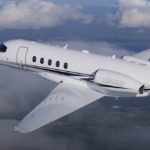When Bombardier launched the C-series narrowbody they said it would be a game changer for the 100-150 seat regional market. Now the Airbus A220 it is proving that point. Like other narrowbodies before it, there is an opportunity to think design for a more luxurious market, as a VIP or head of state aircraft.
FINN would have been paying a visit to EBACE at this time of year and the Airbus A220 would have been one of the talking points of the show. But editor-in-chief Alan Peaford had the opportunity to talk to designers Stephen Vella, CEO of Kestrel Aviation Management and Tom Chatfield, CEO of Camber Aviation Management whose last challenge was to introduce the worlds first VIP BBJ 787.
The cabin of the A220-300 is designed to for up to 16 passengers, providing them with comfortable seating, with areas to dine, entertain, collaborate and relax while providing the cabin crew with the ability to provide exceptional service for the passengers. The entry welcomes passengers into a spacious, well equipped cabin while innovative systems, materials, textures, colours and lighting choices offer a relaxing and functional environment for both short and long journeys.
A220 is satisfying customers’ wants and needs for large cabin market
Stephen Vella said: “The team working on this exciting project actually participated in the Kestrel 787 VIP project. And essentially it was the success of that project that motivated us to fundamentally stop and look at the large cabin market and the needs and wants of the market. So this is a team that’s worked well together that strives in innovation. And we had a steep learning curve with a 787, that a lot of new design features in that aircraft. And we thought, Well, why not leverage that on to a narrow body project that built on what we had achieved on the 787. So the team is just thriving on extending its experience of the 787 to this new plan.”
The team have been working to produce and incredibly different aircraft to the one that Bombardier was originally manufacturing, now marketed as an Airbus. Tom Chatfield explained: “What we really were looking for after the 787 was to find a platform where we could apply this innovation in the narrow body market and the C-series work previously the unit or now, the C Series. Now the A220 proved to be the ideal platform, it’s a clean sheet design. The interior cabin is well suited to be able to configure it into a corporate aircraft. And, and we thought that that would be an ideal launch platform for this concept.”
Step-by-step exploration of design concept
Bringing designers on board including Jacques Pierrejean and Flying Colours didn’t lead to and artistic conflicts. The team are used to working on projects together and Vella said the process involved a step-by-step process exploring the concept.
He added: “The secret to this team is to develop the concept step by step. So, Tom and I were working on this concept of modularity and adaptability. We look at the concept not only from a design point of view, but from a operability, maintainability, accessibility point of view. We look at it from a technical maintenance point of view, we look at it from the customer’s point of view.
“And then very, very important is to bring the detail industrial design and aesthetics into the concept, which is where Jacques joined us. And as and you’re right, he is, he is very talented. The reason this system works is because there’s a sense of mutual respect for each other’s contribution to the concept.”
Demand for business jets would remain after COVID-19 pandemic
Stephen Vella said he thought demand for business jets would remain, despite the disruption to the wider air transport industry due to the COVID-19 pandemic.
“I would say that what we’re doing here is long overdue. Yes, there is an impact from COVID-19 on the overall demand for corporate aircraft. But what we’re trying to develop here is, is rather unique. We’ve taken the big complaints from the user base and tried to address them and what is the big complaint? Well, you know, you’re either going to go and buy a Gulfstream or a global and go down that road of buying a configured aeroplane, or you’re going to go to Airbus or Boeing and buy yourself a green aeroplane and, and design an interior.”
“Many of the complaints that we got from our customer base were related to the cost, the risk and the elapsed time. So what we’re trying to do here is generate a concept that basically costs very little more than a Global 7500 or, or a Gulfstream 700 that has all the benefits of volume that the customer base wants out of a traditional Airbus or Boeing project with the volume of the cabin beam, but as Tom mentioned virtually identical, some cases slightly bigger. What we needed to do as a challenge is, how do we cut the cost? How do we give the customer the features that he wants in the cabin at that lower cost and how do we cut the elapsed time? That was the really big challenge that what do you see as a creation but behind that creation, there’s a lot of deep thought on how to address those three challenges.”

